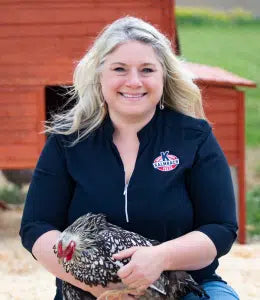Backyard Poultry: More than Just Chickens

Why Did The Chicken Cross the Road?
To visit with the duck, the goose, the turkey, the guinea, the peacock – all of her feathered friends! When we think about backyard poultry, the first thing that comes to mind is usually chickens. However, there are so many great poultry options available today, that we would be remiss to exclude our other feathered friends.
Ducks
Ducks make excellent additions to your backyard flock. In fact, my own flock has some ducks in the mix. Ducks are quickly gaining popularity and provide loads of entertainment! Ducks come in a variety of colors and sizes, and are typically raised for similar purposes as chickens.
Interesting Facts About Ducks:
- Ducks typically reach laying age about 1-2 months after the average chicken.
- Ducks can lay as few as 60 or as many as 300 eggs per year, depending on breed. That is pretty close to the same number of eggs as a chicken!
- Ducks lay their eggs in nests on the ground.
Geese
Geese are amazing animals. They can be very ornamental. Some varieties will have amazing curled feather patterns, tufts on their heads, and even dewlaps that look like beards. Many varieties of geese are known for their protective nature and will alert predators and prowlers alike.
Interesting Facts About Geese:
- Most geese are actually lousy layers! White Chinese Geese are great layers, but only lay about 50 eggs per year.
- Some breeds of geese, like the Tufted Toulouse, will actually have problems mating if they aren’t in the water.
- Some breeds of geese, like Embdens, can reach up to 3 feet tall and can weigh over 25 lbs.
Turkeys
Oh, how I love to watch turkeys grow. They are very curious and love to peck on anything shiny, including your belt buckles and buttons. Turkeys make wonderful additions to any flock. However, you do need to be very careful when raising turkeys with chickens or where an existing flock of chickens has been. Turkeys are susceptible to a disease called blackhead and chickens can be asymptomatic carriers of the parasite that causes blackhead.Interesting Facts About Turkeys:
- It is quite common for newly-hatched turkey poults to be raised in rings to prevent them from crowding into corners.
- There are two main types of turkeys. The broad-breasted varieties are meant to be meat birds. The heritage varieties can be used for lots of different purposes including meat birds, layers, and even pets.
- A heritage variety called Narragansett was one of the most popular domesticated turkeys during our country’s founding in the 1700s. By the 1990s, it was nearly extinct with only 10 breeding turkeys left. Through the hard work of some very dedicated people, we still have Narragansett turkeys today.
Guineas, Peafowl, and Game Birds
Whether it is the distinctive cackle of a guinea, or the fluttering fan of a strutting peacock, it’s hard to see these birds in action and not want a few in your flock. Guineas have very distinct facial features and make excellent watchdogs. Peafowl speak for themselves. Peacocks have massive feathers that they proudly display for their potential mates. Game birds, like quail and pheasants, can also make great additions to your flock.
Interesting Facts About Guineas, Peafowl, and Gamebirds:
- Guineas have beautiful feathers that have perfect polka dot patterns. If I were a milliner, I would have guineas!
- The feathers on peacocks are often iridescent. The more the feathers shimmer, they more likely they are to attract a mate.
- The coturnix quail, a breed of gamebird, reach a maximum weight of around 5 ounces. Despite their tiny size, they mature very quickly and start laying eggs around 8 weeks of age.
